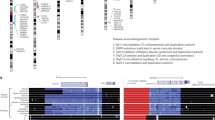Abstract
Many studies have suggested that the modern cloverleaf structure of tRNA may have arisen through duplication of a primordial hairpin, but the timing of this duplication event has been unclear. Here we measure the level of sequence identity between the two halves of each of a large sample of tRNAs and compare this level to that of chimeric tRNAs constructed either within or between groups defined by phylogeny and/or specificity. We find that actual tRNAs have significantly more matches between the two halves than do random sequences that can form the tRNA structure, but there is no difference in the average level of matching between the two halves of an individual tRNA and the average level of matching between the two halves of the chimeric tRNAs in any of the sets we constructed. These results support the hypothesis that the modern tRNA cloverleaf arose from a single hairpin duplication prior to the divergence of modern tRNA specificities and the three domains of life.





Similar content being viewed by others
References
Di Giulio M (1995) Was it an ancient gene codifying for a hairpin RNA that, by means of direct duplication, gave rise to the primitive tRNA molecule? J Theor Biol 177:95–101
Di Giulio M (1999) The non-monophyletic origin of the tRNA molecule. J Theor Biol 197:403–414
Dick T, Schamel W (1995) Molecular evolution of transfer RNA from two precursor hairpins: implications for the origin of protein synthesis. J Mol Evol 41:1–9
Eigen M, Winkler-Oswatitsch R (1981) Transfer-RNA, an early gene? Naturwissenschaften 68:282–292
Felsenstein J (1978) Cases in which parsimony and compatibility methods will be positively misleading. Syst Zool 27:401–410
Jukes TH (1995) A comparison of mitochondrial tRNAs in five vertebrates. J Mol Evol 40:537–540
Maizels N, Weiner A. (1994) Phylogeny from function: Evidence from the molecular fossil record that tRNA originated in replication, not translation. Proc Natl Acad Sci USA 91:6729–6734
Nagaswamy U, Fox GE (2003) RNA ligation and the origin of tRNA. Orig Life Evol Biosph 33(2):199–209
Nei M, Kumar S, Takahashi K (1998) The optimization principle in phylogenetic analysis tends to give incorrect topologies when the number of nucleotides or amino acids used is small. Proc Natl Acad Sci USA 95:12390–12397
Randau L, Münch R, Hohn M, Jahn D, Söll D (2005) Nanoarchaeum equitans creates functional tRNAs from separate genes for their 5′- and 3′-halves. Nature 433:537–541
Saks ME, Sampson JR, Abelson J (1998) Evolution of a transfer RNA gene through a point mutation in the anticodon. Science 279(5357):1665–1670
Schimmel P, Henderson B (1994) Possible role of aminoacyl-RNA complexes in noncoded peptide synthesis and origin of coded synthesis. Proc Natl Acad Sci USA 91(24):11283–11286
Sprinzl M, Vassilenko KS (2005) Compilation of tRNA sequences and sequences of tRNA genes. Nucleic Acids Res 1:33, D139–D140
Tamura K, Schimmel P (2001) Oligonucleotide-directed peptide synthesis in a ribosome- and ribozyme-free system. Proc Natl Acad Sci USA 98:1393–1397
Weiner A, Maizels N (1987) tRNA-like structures tag the 3′ ends of genomic RNA molecules for replication: Implications for the origin of protein synthesis. Proc Natl Acad Sci USA 84:7383–7387
Yaniv M, Folk WR, Berg P, Soll L (1974) A single mutational modification of a tryptophan-specific transfer RNA permits aminoacylation by glutamine and translation of the codon UAG. J Mol Biol 86:245–260
Acknowledgments
This work was supported by a seed grant from the W. M. Keck Foundation RNA Bioinformatics Initiative. We thank members of the Knight and Yarus labs for critical discussion of the manuscript.
Author information
Authors and Affiliations
Corresponding author
Additional information
[Reviewing Editor: Dr. Niles Lehman]
Rights and permissions
About this article
Cite this article
Widmann, J., Giulio, M.D., Yarus, M. et al. tRNA Creation by Hairpin Duplication. J Mol Evol 61, 524–530 (2005). https://doi.org/10.1007/s00239-004-0315-1
Received:
Accepted:
Published:
Issue Date:
DOI: https://doi.org/10.1007/s00239-004-0315-1




